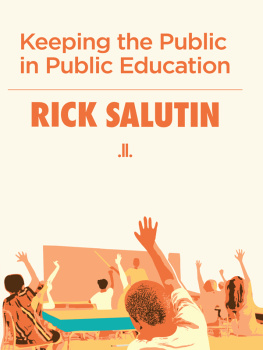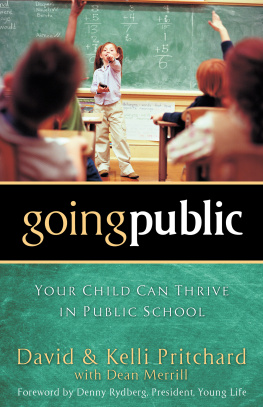Keeping the Public
in Public Education
RICK SALUTIN

For Mrs. McCuaig,
Mr. Colgrove and
all the other teachers
TABLE OF CONTENTS
Introduction: The Sector That Dares Not Speak Its Name
These are strange times. The private sector, whatever that means exactly, seems able to do no wrong and to shake off any wrong it does while the public sector dares not utter its name for fear of derision and worse.
For 30 to 40 years, everywhere in the world, the private sector has proceeded from triumph to triumph. It shook off or loosened most of the regulations that were imposed on it after the Great Depression and the economic disaster of the 1930s. Those included limits on expansion and monopoly that were meant, in the spirit of capitalisms own creed, to guarantee the benefits of competition. Rules were laid down to prevent fraud and deception, along with subtler forms of manipulation.
Many of those controls have now been eliminated. Where they persist, the bodies charged with investigating and applying them have been starved for funding and staff. A revolving door exists through which regulators and the regulated change places regularly. This leaves the oversight bodies with little reason to act seriously, not to mention severely, with their prospective employers.
The same is true of regulation in other areas, like the environment. The New York Times reported in September of 2011, an ExxonMobil pipeline carrying oil across Montana burst suddenly, soiling the swollen Yellowstone River with an estimated 42,000 gallons of crude just weeks after a company inspection and federal review had found nothing seriously wrong. The story was headed, Pipeline agency chronically undermanned.
In Canada under the Harper government, the current round of deregulation combined with undermining oversight meant getting rid of the President of the Canadian Wheat Board, the Chair of the Nuclear Safety Commission, and, by way of his resignation after a bitter conflict over the census, the head of Statistics Canada. The ability to assemble data in order to figure out whats going wrong in the country has been undercut by eliminating the long form of the national census along with a database that had been used for access-to-information requests.
A major constraint on reckless behaviour by employers collective activity by their employees in the form of trade unionism was attacked and weakened. The opening shots were fired by President Ronald Reagan against air traffic controllers in the U.S. in 1981 and by Prime Minister Margaret Thatcher against miners in the U.K. in 1984-85. Companies spent freely to develop strategies and train management in techniques for combating and intimidating unions. Anti-union experts and consultants flourished.
This was accompanied by a parallel cultural assault. The labour beat disappeared in the news media, while business coverage expanded massively, including pro-business programming on public broadcasters like PBS in the U.S. and CBC in Canada. In 2011, CBC promoted its nightly hour on business on television in the words of host-journalist Amanda Lang: I think what is really special about the show is that it does celebrate business. No one in the world of media was celebrating labour or the public sector and definitely not for an hour each night. Union membership declined severely. Even where contracts still existed, employers increasingly violated them, knowing there was little chance of enforcement by governmental labour boards. One sign of victory in this contest: the gap between CEOs and their employees rose to 325 times what the latter earned. Fifty years earlier, it had been about 25-1.
In North America, part of this triumphal advance was a strategy to generate higher profits by using agreements on free trade to move production to areas of cheaper labour. So Canadian factories shut down; their equipment and jobs were shipped, often in the first instance to southern U.S. states, many of which had anti-labour laws, or from the U.S. to Mexico. Then, if labour in those places became too costly, the jobs moved again, sometimes to China, and on from there when costs rose again.
This left a problem: how to continue making good money in the (formerly) home markets, where workers wages and purchasing power had stagnated or fallen. Part of the answer was to siphon off some of the money that seemed to be sloshing around in the public sector, in areas like health care and education, funded by taxes. In the U.S., although the medical sector was largely private, there were substantial public expenditures on the elderly and the poor. Large corporations in the form of Health Management Organizations (HMOs) moved in on funding sources that had been previously dominated by individual GPs and specialists, while during the George W. Bush years drug companies successfully lobbied for laws that gave them privileged access to the same public money.
In Canada and the U.K., soothing names like public-private partnerships were used in the construction of new hospitals and highways: the bulk of money spent and the risks taken were public but the profits were private. Public education was harder to exploit but offered a huge pool of potential profit; it was tapped, for example, by way of vouchers used to pay for private schooling with public funds, indirect privatization via charter schools, again paid for publicly, or by establishing highly profitable standardized testing and marketing businesses, consulting firms, etc.
The economic collapse of 2008 (and counting), in which millions lost jobs and homes, centered on the financial sector. Its roots were planted a decade earlier, during the liberal Clinton era in the U.S. and the New Labour Blair era in the U.K., through deregulation of financial markets and institutions. That led to self-dealing, by which banks and others were free to rig and hide dubious transactions done with new devices they invented that were incomprehensible. These contraptions had impenetrable names like credit default swaps and bundled mortgages. They cleared the way for the housing bubble in the U.S., which spread its effects everywhere owing to the globalization of financial markets.
Behind the housing bubble was a desperate need for expansion of consumer credit in the U.S. in order to sustain growth in its economy and that of the rest of the world, which had grown dependent on exporting products to the U.S. With the decline of wages among average Americans, consumer demand in the U.S. had dwindled over the years of free trade and job export. Americans overvalued homes became their private ATMs, until the bubble burst.
When that happened, with impacts everywhere, and financial institutions like Lehman Brothers began to implode, the private sector summoned the public sector to its aid. It came swiftly, even in the midst of a U.S. presidential election. Huge bailouts followed, paid for with the tax money of ordinary citizens, and those financial institutions which now dominated the private sector in the U.S. survived, or at worst were taken over (with the exception of Lehman Brothers, R.I.P.). The carnage among homeowners and ordinary working people was vast. At no point did the financial institutions, bankers or the diminishing number of captains of industry admit any serious responsibility. They never waived their huge incomes or bonuses. They continued to pay and over-reward themselves, even as joblessness and home foreclosures rose. That refusal to accept responsibility was even more offensive than the greed. Who knows where it might eventually lead? There was no serious re-regulation to assure it all wouldnt happen again, and soon. The revolving door continued to spin. The recovery was tepid. At the moment another, deeper, crash seems imminent.









